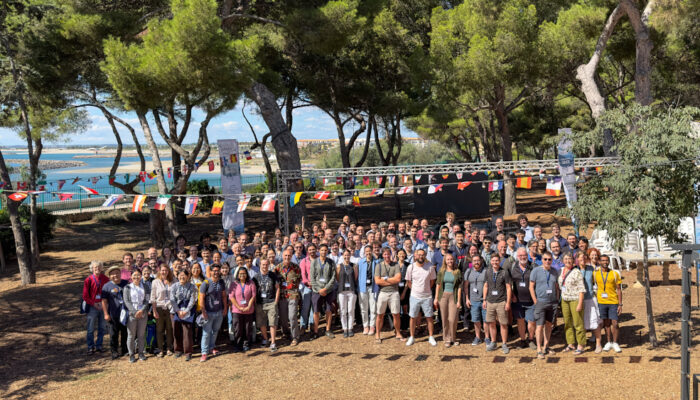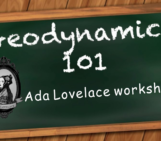
Ada Lovelace Poster Awardees
A new edition of the Ada Lovelace workshop took place this year in Sète (1-6 septembre 2024), in the exceptional setting of the Domaine du Lazaret by the Mediterranean Sea. Sincere thanks go to Fanny Garel, Catherine Thoraval, and all the Montpellier team for the excellent organization of this event.
This worshop provided an opportunity for the community of mantle and lithosphere dynamic modelers to come together. Invited talks, formatted as long sessions (40 minutes), were followed by extended Q&A periods, fostering inspiring and constructive exchanges about the future direction of research. Tutorials and daily roundtables were also organized. In addition, more than a hundred posters were presented, offering an overview of cutting-edge work being conducted within the community. Among these, outstanding early career scientists particularly stood out and received the best poster award. This post aims to highlight their research and gather their impressions of the conference (in alphabetic order).
Poster Awardees !
Hello, I’m Anaïs Cochet. I am currently working as a PhD student at the University of Rennes, under the supervision of Philippe Yamato. My PhD work is part of the ANR Metrology project (Impact of MEtamorphic TRansformation On the rheoLOGY of rocks). My research primarily focuses on the numerical modeling of metamorphic transformations in rocks and I am more specifically interested in understanding thermo-hydro-chemical-mechanical couplings in reactive rocks. One of the main issues I am dealing with is understanding the propagation of eclogitization in granulites through numerical modeling. Participating in the AdaLovelace workshop was a great opportunity for me to meet other early-career researchers in related fields of study, as well as to engage in discussions with senior scientists.
Hi, I’m Arne Glink, a final-year PhD student working on a joint project between the University of Hamburg and GEOMAR in Kiel. My research, in collaboration with Jörg Hasenclever and Lars Rüpke, focuses on numerical modeling of the interaction between tectonic and hydrothermal processes at slow-spreading mid-ocean ridges. At the workshop, I presented our recent work on sulfide deposition linked to hydrothermal venting around oceanic core complexes and the associated detachment faults. By coupling the output of a thermo-mechanical detachment model to a porous flow model, we explored how factors like permeable faults and variable heat sources influence hydrothermal venting. Two key insights from our study are that the focusing of high-temperature fluid discharge through faults is strongly constrained by fault geometry and permeability, and that even small, transient shallow heat sources can drive significant, large-scale, and long-lasting flow focusing. At the workshop, I presented our recent work on sulfide deposition linked to hydrothermal venting around oceanic core complexes and the associated detachment faults. The Ada Lovelace Workshop was a fantastic opportunity to engage with the geodynamics community, gain valuable insights from other researchers, and, just as importantly, connect with amazing people in the stunning setting of the French Mediterranean coast.
My name is Kai Li and I am currently a PhD student at GFZ and Freie Universität Berlin, Germany, in geodynamic modeling. My research focuses on exploring the impact of orogenic inheritance on rift evolution. I work under the supervision of Prof. Sascha Brune and Dr. Zoltán Erdős.. At the Ada Lovelace Workshop, I presented my poster on “Quantifying the Influence of Orogenic Inheritance on Rifted Margin Formation through Wilson Cycle Modelling.” This work explores the extent to which orogenic inheritance should be considered in rift evolution within the Wilson Cycle. To address this question, a numerical forward model was applied, integrating the geodynamic finite element code ASPECT with the landscape evolution software FastScape. The simulations include phases of continental collision, post-orogenic collapse, continental rifting, and breakup, using velocity boundary conditions that transition from compression to extension over time. After a quantitative analysis and comparison with homogeneous lithosphere models without orogenic inheritance, we find that for weaker lithospheres, orogenic inheritance has a reduced impact, as these regions tend to be dominated by ductile deformation. It was an enriching experience. I had the chance to engage with the geodynamics community, exchange ideas, and enjoy the beautiful sunshine in Sète.
I am Ziqi Ma, a third-year PhD student at University College London, working with Dr. Maxim Ballmer and Dr. Antonio Manjón-Cabeza Córdoba. My research focuses on studying plume-lithosphere interaction, aiming to establish a scaling law between plume buoyancy flux and surface dynamic topography using numerical models that incorporate composite rheology and a free surface. The experience I had at the Ada Lovelace Workshop was incredibly rewarding and enjoyable. I received valuable feedback from both peers and experts in my field. Additionally, I met many friendly people, attended insightful talks, and spent great moments on the beach, enjoying delicious food and breathtaking sunsets every day. Overall, this workshop has been the best conference I’ve attended during my PhD so far! I sincerely appreciate the efforts of the organizers in making this event possible.
I’m Abi Plimmer,a final year PhD researcher at Cardiff University working with Prof Huw Davies on the project: “Constraining the relationship between mantle circulation and supercontinent cycles”. My poster focussed on the work I have been doing to integrate a more complex lithosphere into 3D mantle circulation models by differentiating oceanic, continental, and cratonic domains by viscosity and thickness. The study sought to explore the impact of lithosphere heterogeneity on mantle circulation from supercontinent formation to breakup, and found that small changes at the surface are capable of effecting slab and plume dynamics in the deep Earth.
This was my second time attending the Ada Lovelace workshop, after first attending in Hungary two years ago. The workshop was committed to highlighting the voices of Early Careers Researchers which was a great way to integrate new scientists into the geodynamics community. Overall, it was a week of great science, great scenery, and a lot a karaoke.
My name is Sandrine Ritter and I am a PhD student at ETH Zurich in the Geophysical Fluid Dynamics group, working with Taras Gerya and Attila Balázs. My PhD focuses on oceanic transform fault zones, where my first project is about trying to understand the influence of different weakening mechanisms on the evolution of transform fault zones. Other projects of my PhD include unraveling surface and biodiversity processes in this geological setting. During the Ada Lovelace conference I presented in particular models involving strain rate weakening with visco-elasto-plastic rheology from continental break-up to fully developed oceanic transform fault zone. Ongoing work presented included a first look at the plastic strain rate distribution over time. In addition to the wonderful location, the discussions with experts were very helpful to get different opinions or ideas on parts that are still in progress.

poulami@gfz-potsdam.de











